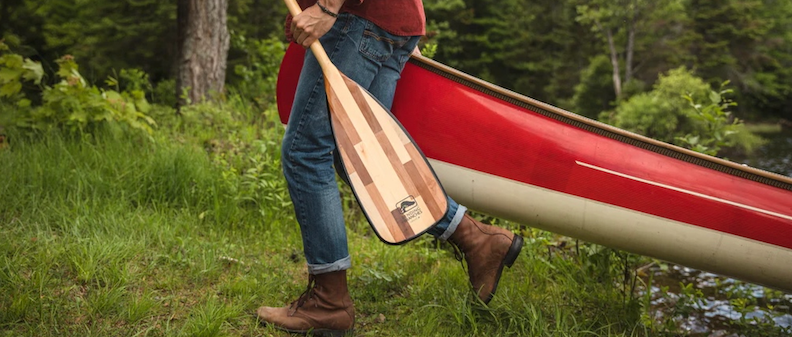“There’s magic in the feel of a paddle and the movement of a canoe, a magic compounded of distance, adventure, and solitude, and peace.”
A canoe paddle is your connection to the water – it controls your boat's direction and propels you to your destination. Learn about price, materials, size, grips, blades and more.
PRICE
A canoe paddle is a great place to invest extra money. Canoe paddle prices are typically based on materials and quality of craftsmanship.
Common paddle materials from most to least expensive:
- Carbon Fiber $$$
- Fiberglass & Wood $$
- Aluminum Shafts $
- Plastic Blades $
There are additional choices that affect the price of a canoe paddle.
Larger blades add to the price and bent shaft paddles generally cost 10% more than a straight shaft paddle.
For durability, quality wood blades are wrapped in fiberglass, and more economical wood paddles are coated with epoxy or varnish.
First Water Boats is a Bending Branches Paddles dealer. The world's largest manufacturer of quality canoe and kayak paddles, Bending Branches has been outfitting paddling enthusiasts for over 40 years
PADDLE SHAFTS
Straight ShaftThe most powerful part of the stroke is when the blade is vertical in the water, and your energy pulls the canoe forward. Near the beginning of the stroke, when the paddle is in front of the canoeist, a straight paddle blade will be vertical. As it moves through the stroke, the straight paddle will angle up and out of the water, slightly lifting it and making it less efficient.

Straight paddles are great for:
- technical waters
- stern paddlers
- solo canoeists
Bow paddlers also often prefer a straight paddle
for its ease of use and intuitive turning.
Bent Shaft
A bent shaft paddle bends forward about 11 degrees where the shaft and blade meet (the logo usually faces the canoe's bow).
The bent shaft extends the time when the canoe paddle is vertical in the water, producing more power throughout the stroke. That power peaks in the middle of the stroke when your top hand is level with your shoulder, reducing fatigue.
However, turning a canoe is less intuitive with a bent shaft.


- flat water
- long trips
- bow paddlers
Stern paddlers often use bent shaft paddles too,
especially when travelling long distances at speed on flat water.
Shaft Material:
Every time a shaft flexes, it wastes energy. Every extra ounce adds up. The farther you go, the more you will appreciate a paddle with a high stiffness-to-weight ratio.
Carbon fiber is by far the stiffest and lightest option. The higher price tag is worth it if you want to save energy and go fast. Carbon shafts are smooth and almost soft to the touch. Carbon fiber is also excellent against fatigue failure, so barring any impact, it will last a long time.
Wood shafts are a durable and beautiful classic option, but the solid shaft is relatively heavy. Wood shafts are an excellent choice for recreational, youth, and expedition paddlers or someone looking for a paddle to last a long time.


Aluminum shafts are impact-resistant and the most economical option. However, aluminum is the heaviest option and is prone to fatigue failure over time.
BLADE
Size
Therefore, you see marathon and excursion paddlers with small blades using a high cadence. Yet whitewater canoeists and short-distance paddlers often use large blades. They rely on the large surface area to quickly generate a lot of power.

A teardrop-shaped blade with square tips ("Sugar Island" profile) is more efficient for paddling. It is quiet and smooth at entry and exit. They have less surface area and, in turn, are less fatiguing.
The advantage of the long "Beavertail" blade is its ability to steer and generate more power. As you turn your paddle to straighten the canoe, more blade is in the water to initiate the turn. This makes Beavertail paddles excellent for solo and stern canoeists. Remember that with the increased blade length, you need deeper water to get the whole blade below the surface, requiring more work per stroke. You will notice solo canoeists with a Beavertail paddle take long, slow strokes with an exaggerated turn at the end to keep the boat on course.
MATERIAL
Blade material choices are carbon fiber, wood, fiberglass, and plastic. Carbon fiber is again the lightest, most efficient, and most expensive option. Carbon fiber is prone to crack failure due to high impact. So, extra caution must be taken in rocky waters if you go with a carbon fiber blade. Don't push off of rocks with it to get away from shore. Carbon fiber blades dominate the market amongst racers and deep water users.


GRIP

LENGTH
Paddle length is measured with the blade on the floor and the shaft vertical. Paddle length is from the floor to the top of the handle. There is no method to choose paddle length that works for everyone in every canoe. Paddle length ultimately becomes a personal preference.
What are the signs of incorrect paddle length?
If your canoe paddle is too short, you will be overreaching, or the paddle will skim the surface, and you will not get proper power. If it's shorter, the paddle will be submerged entirely throughout the entire stroke, efficiently wasting energy as you battle to keep it from wobbling at the start and end.
Paddlers who travel long distances prefer to keep their top hand lower to reduce fatigue. Others who want a more powerful stroke will have a longer paddle where their top hand is higher, increasing their leverage.
So what is the best length? It depends on two factors primarily. First is the length of your torso, and second is the distance from your canoe seat to the water line.
Method #1
Straight Paddle
You want your paddle fully submerged at the beginning of your stroke, where the blade is vertical. The blade will be slightly in front of you. When using a straight paddle, your top hand should be level with your nose.
Bent Shaft Paddle
Method #2
Note: If you are using a beavertail blade, add 2-4" inches
to accommodate the longer blade,
which should be completely submerged
when the blade is vertical in the water.
| Torso Length | Bent Shaft Paddle Length | Straight Paddle Length |
| 26" | 26"+22"=48" | 26"+26"=52" |
| 28" | 50" | 54" |
| 30" | 52" | 56" |
| 32" | 54" | 58" |
| 34" | 56" | 60" |

